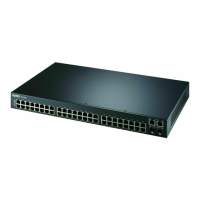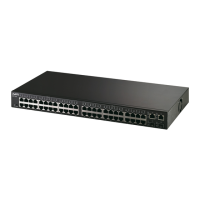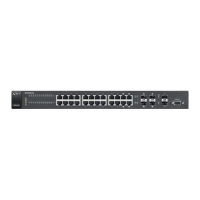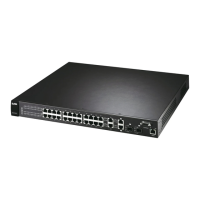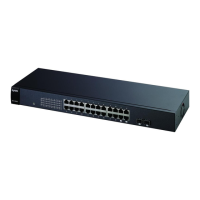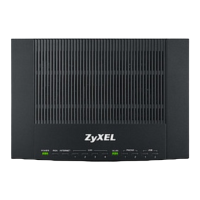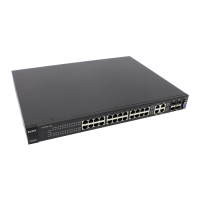
Do you have a question about the ZyXEL Communications ZyXEL Dimension ES-4124 and is the answer not in the manual?
| Brand | ZyXEL Communications |
|---|---|
| Model | ZyXEL Dimension ES-4124 |
| Category | Switch |
| Language | English |
Provides essential information for operating and managing the ES-4124 switch.
Details for initial access to the switch's web configurator, including default credentials.
Instructions for securely installing the switch into a standard network rack.
Steps to access the switch's web interface and log in using default credentials.
Procedures for resetting the switch to factory defaults via console port.
Details on setting up IP interfaces and routing domains on the switch.
Explains how to configure the switch to assign IP addresses to DHCP clients.
Describes how to view the port statistical summary on the status screen.
Details for viewing switch information like firmware version and hardware monitoring.
Configuration options for system name, time, and location settings.
Configuration for default gateway, domain name server, and IP domains.
Settings for configuring individual switch port parameters.
Configuration for Virtual Local Area Networks, including 802.1Q tagged and port-based VLANs.
Configuration and status for STP, RSTP, and MSTP to prevent network loops.
Setup for IEEE 802.1x and MAC authentication methods for port access control.
Filtering unauthorized DHCP and ARP packets using binding tables and inspection.
Configuration for static VLANs to control frame forwarding based on VLAN tags.
Manually entering static MAC addresses in the MAC address table for port forwarding.
Activating STP modes like RSTP, MRSTP, or MSTP on the switch.
Configuration steps for Rapid Spanning Tree Protocol (RSTP) settings.
Configuration screen for setting bandwidth limits using CIR and PIR.
Configuration screen for enabling static and dynamic link aggregation.
Activating authentication methods (802.1x, MAC) and configuring RADIUS server details.
Configuration screen for enabling port security and managing MAC address learning.
Defining classifiers to group traffic based on specified criteria.
Steps to define actions for classified traffic flows.
Configuration screen for selecting and setting queuing algorithms.
Steps to configure VLAN stacking on the switch ports.
Multicast VLAN Registration (MVR) for sharing multicast VLANs among subscribers.
Configuration of RADIUS and TACACS+ server settings for AAA services.
Viewing statistics and status of the DHCP snooping database.
Configuration steps to enable loop guard on the switch ports.
Configuration of static routes for manual IP traffic forwarding.
Configuration of Open Shortest Path First (OSPF) routing protocol.
Configuration of the switch as a multicast router using IGMP.
Manual configuration of static routes for IP traffic forwarding.
Activating OSPF and configuring general settings like router ID and redistribution.
Traffic policing methods using CIR and PIR to measure traffic flows.
Enabling DiffServ to apply marking rules or IEEE 802.1p priority mapping.
Configuring DHCP relay for clients not in the same broadcast domain.
Configuration of VRRP parameters including IP interface and virtual router settings.
Managing firmware, configuration files, and system reboot.
Controlling access to the switch via console, SSH, Telnet, FTP, Web, and SNMP.
Tools for checking system logs, pinging IP addresses, and performing port tests.
Configuration for sending event notification messages to a syslog server.
Procedure for downloading and uploading new firmware versions to the switch.
Overview of commands and their availability in User and Enable modes.
Commands for enabling and configuring switch features.
Common configuration commands related to switch interfaces and ports.
Commands for configuring port-channel interfaces and related features.
Commands to enable and configure Spanning Tree Protocol (STP/MRSTP).
Resolving issues related to accessing the switch via Telnet or web configurator.
